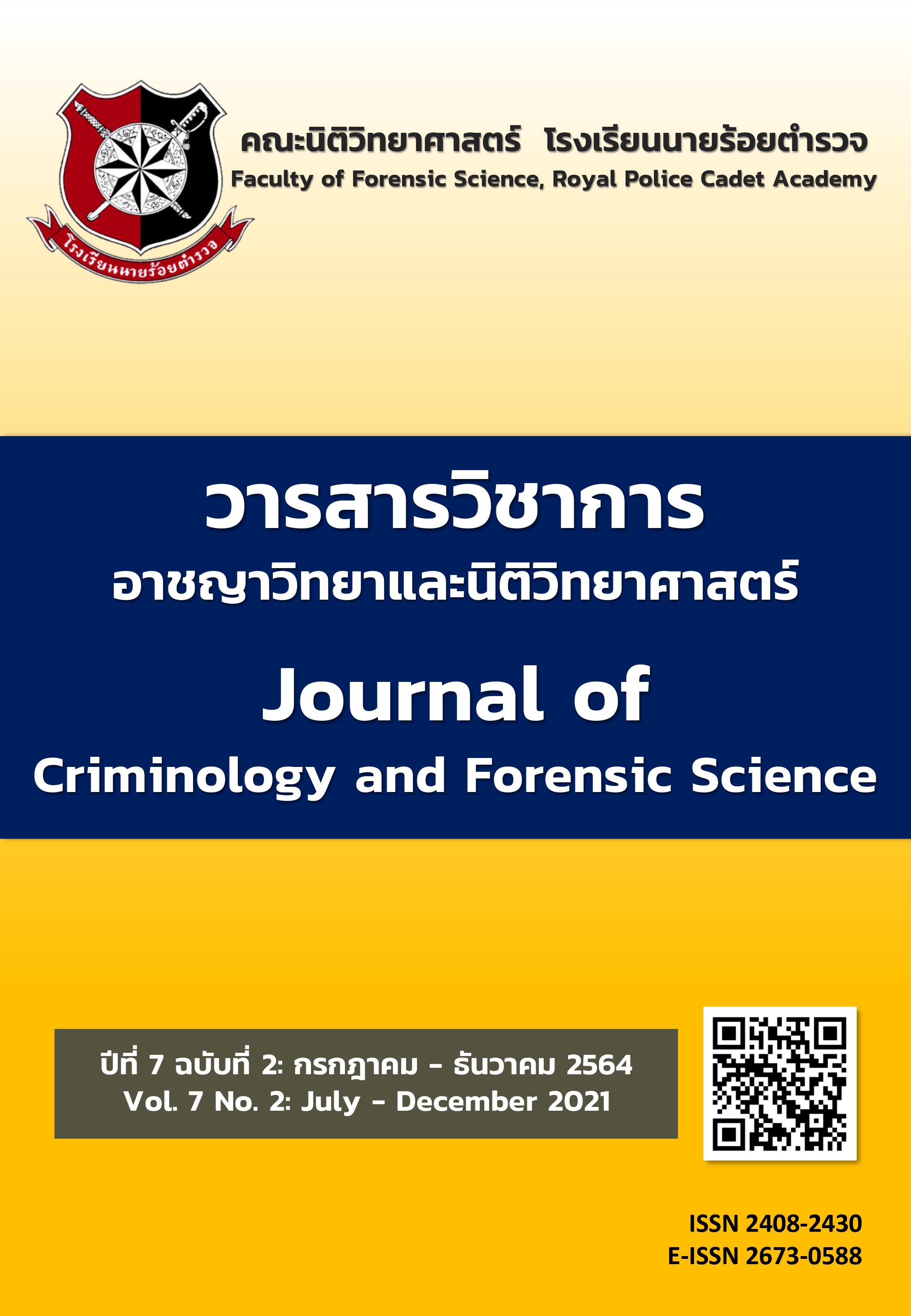การประยุกต์ใช้ตัวดูดซับในการเตรียมตัวอย่างสำหรับการตรวจพิสูจน์น้ำมันเบนซินจากวัตถุพยานด้วยเทคนิคเฮดสเปซ-แก๊สโครมาโทกราฟี-แมสสเปกโตรเมตรี
Main Article Content
บทคัดย่อ
การตรวจพิสูจน์พยานหลักฐานทางนิติวิทยาศาสตร์เพื่อวิเคราะห์หาชนิดของน้ำมันเชื้อเพลิงที่ติดอยู่กับวัตถุพยานจากเหตุเพลิงไหม้ด้วยเทคนิคแก๊สโครมาโทกราฟี-แมสสเปกโตรเมตรี (gas chromatography-mass spectrometry หรือ GC-MS) นั้น ในบางครั้งจำเป็นต้องมีการสกัดเอาน้ำมันเชื้อเพลิงออกจากวัตถุพยานเนื่องจากวัตถุพยานมีขนาดใหญ่หรือมีน้ำเจือปน ซึ่งทำให้มีการทำลายวัตถุพยานและสูญเสียน้ำมันเชื้อเพลิงระหว่างขั้นตอนการสกัด ดังนั้นงานวิจัยนี้จึงมีวัตถุประสงค์เพื่อประยุกต์ใช้ตัวดูดซับสำหรับการวิเคราะห์น้ำมันเบนซินที่ติดอยู่กับวัตถุพยานด้วยเทคนิคเฮดสเปซ-แก๊สโครมาโทกราฟี-แมสสเปกโตรเมตรี (Headspace Gas Chromatography-Mass Spectrometry หรือ HS-GC-MS) ซึ่งเป็นวิธีที่ไม่ทำลายตัวอย่าง โดยทดลองใช้ตัวดูดซับ 3 ชนิด ได้แก่ คาร์บอนสตริป ถ่านกัมมันต์ และถ่านไม้ไผ่ แล้วศึกษาความสามารถในการดูดซับน้ำมันเบนซิน เปรียบเทียบกับวิธีการสกัดเอาน้ำมันเบนซินออกจากวัตถุพยานแล้วทำการตรวจวิเคราะห์ด้วยเทคนิค GC-MS ผลการทดลองพบว่าภายใต้สภาวะการดูดซับที่อุณหภูมิ 60๐C นาน 8 ชั่วโมง ตัวดูดซับชนิดคาร์บอนสตริปมีประสิทธิภาพในการดูดซับน้ำมันเบนซินสูงกว่าถ่านกัมมันต์และถ่านไม้ไผ่ อย่างมีนัยสำคัญ (p<0.05) และค่าร้อยละการกลับคืนเฉลี่ยของตัวดูดซับคาร์บอนสตริป ถ่านกัมมันต์ และถ่านไม้ไผ่ เมื่อวิเคราะห์ด้วยเทคนิค HS-GC-MS เท่ากับ 85.22, 68.97 และ 38.42 ตามลำดับ และเมื่อวิเคราะห์ด้วยเทคนิค GC-MS เท่ากับ 79.94, 56.34 และ 40.29 ตามลำดับ หลังจากนั้นจึงนำตัวดูดซับคาร์บอนสตริปไปทดสอบประสิทธิภาพในการตรวจพิสูจน์น้ำมันเบนซินที่ตกค้างอยู่ในวัตถุพยานจำลอง 4 ชนิด คือ เสื้อผ้า กระดาษ ไม้อัด และดิน พบว่าการวิเคราะห์น้ำมันเบนซินด้วยเทคนิค HS-GC-MS โดยไม่สกัดตัวดูดซับ มีค่าร้อยละการวิเคราะห์กลับคืนสูงกว่าเทคนิค GC-MS โดยการสกัดตัวดูดซับและวัตถุพยาน อย่างมีนัยสำคัญ (p<0.05) จากการศึกษาในงานวิจัยนี้จึงสรุปได้ว่าคาร์บอนสตริปสามารถนำมาใช้เป็นตัวดูดซับสำหรับการตรวจพิสูจน์น้ำมันเบนซินจากวัตถุพยานด้วยเทคนิค HS-GC-MS ได้ดีที่สุด โดยไม่ต้องทำลายตัวอย่าง
Article Details
เนื้อหาและข้อมูลในบทความที่ลงตีพิมพ์ใน วารสารวิชาการอาชญาวิทยาและนิติวิทยาศาสตร์ โรงเรียนนายร้อยตำรวจ ถิอว่าเป็นข้อคิดเห็นและความรั้บผิดชอบของผู้เขียนบทความโดยตรงซึ่งกองบรรณาธิการวารสาร ไม่จำเป็นต้องเห็นด้วยหรือรับผิดชอบใดๆ
บทความ ข้อมูล เนื้อหา รูปภาพ ฯลฯ ที่ได้รับการตีพิมพ์ใน วารสารวิชาการอาชญาวิทยาและนิติวิทยาศาสตร์ ถือว่าเป็นลิขสิทธิ์ของวารสาร วารสารวิชาการอาชญาวิทยาและนิติวิทยาศาสตร์ หากบุคคลหรือหน่วยงานใดต้องการนำทั้งหมดหรือส่วนหนึ่งส่วนใดไปเผยแพร่ต่อหรือเพื่อกระทำการใดๆ จะต้องได้รับอนุญาตเป็นลายลักษณ์อักษรจาก วารสารวิชาการอาชญาวิทยาและนิติวิทยาศาสตร์ ก่อนเท่านั้น
เอกสารอ้างอิง
Ahmedna, M., Marshallb, W.E. and Raoa, R.M. (2000). Production of granular activated carbons from select agricultural by-products and evaluation of their physical, chemical and adsorption properties. Bioresource Technology. 71, 113-123.
Asada, T., Ishihara, S., Yamane, T., Toba, A., Yamada, A. and Oikawa, K. (2002). Science of bamboo charcoal: Study on carbonizing temperature of bamboo charcoal and removal capability of harmful gases. Journal of Health Science. 48 (6), 473-479.
ASTM E1618-11. (2011). Standard Test Method for Ignitable Liquid Residues in Extracts from Fire Debris Samples by Gas Chromatography-Mass Spectrometry. ASTM International, West Conshohocken, PA.
ASTM. E1412-12. (2012). Standard Practice for Separation of Ignitable Liquid Residues From Fire Debris Samples by Passive Headspace Concentration with Activated Charcoal. ASTM International, West Conshohocken, PA.
ASTM. D5769-20. (2020). Standard Test Method for Determination of Benzene, Toluene, and Total Aromatics in Finished Gasolines by Gas Chromatography/Mass Spectrometry. ASTM International, West Conshohocken, PA.
Eser, S. (2020). Introduction to Petroleum Refining and Crude Oil Composition. Retrieved January 9, 2021, from https://www.e-education.psu.edu/fsc432/node/3
Ferreiro-González, M., Ayuso, J., Álvarez, J.A., Palma, M. and Barroso, C.G. (2015). Application of HS–MS for detection of ignitable liquids from fire debris. Talanta. 142,150-156.
Kocharit, A. (2002). Analysis of volatile organic compounds (VOCs) in the air by Headspace Gas Chromatography (HS-GC). Master of Science (Analytical Chemistry) Thesis Prince of Songkhla University, Songkhla province. (In Thai)
Menakanit T. (2019). Criminal Law Code: Reference Issue. 42th ed. Bangkok: Winyuchon (in Thai).
Niels, K., Jorgensen, NK. and Cohr, KH. (1981). n-Hexane and its toxicologic effects. Scand J work environ health. 7, 157-168.
Raruenrom J. (2008). Application of activated carbon to the identification of flammable liquids. Master of Science (Forensic Science) Thesis Silpakorn University, Nakhon Pathom province (Thesis) (In Thai).
Thambandit, J. (2011). Efficiency Testing of Bamboo Charcoal Using as an Adsorbent for Flammable Liquids. Master of Science (Forensic Science) Thesis Chiang Mai University, Chiang Mai. (In Thai).
Watarai, S. and Tana. (2005). Eliminating the carriage of Sallmonella enteriaca serova enteritidisin domestic fowls by feeding activated charcoal bark containing wood vinegar liquid (Nekka-rich). Pourlty Science. 84, 515-521.


